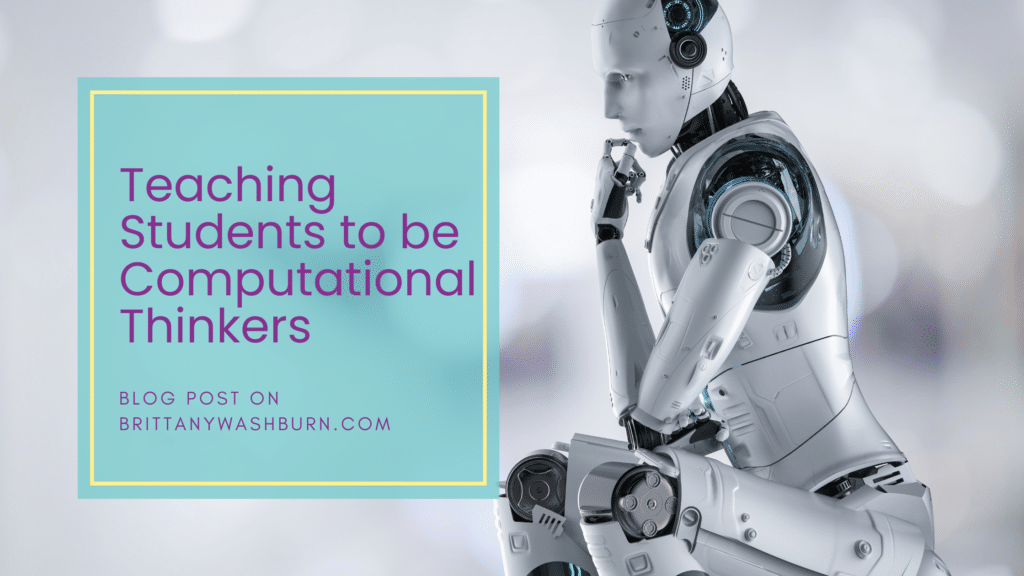Teaching Students to be Computational Thinkers

Computational thinking is a crucial skill for students to develop in today’s technology-driven world. It is the ability to approach problems in a way that a computer can help solve them, breaking it down into smaller, manageable parts that can be analyzed, and reaching a logical conclusion. Teaching students to be computational thinkers can open up a world of opportunities, from developing problem-solving skills to creating innovative solutions. In this article, we will provide tips on how to teach computational thinking skills to students, including how to incorporate it into daily lessons, promote collaboration and critical thinking, and assess and evaluate their skills.
Understanding Computational Thinking
What is Computational Thinking?
Computational thinking involves breaking down complex problems and creating solutions through logical and algorithmic reasoning. It involves using a set of problem-solving skills and techniques that are common to computer science and other fields of study. Computational thinking focuses on identifying patterns, developing algorithms, and creating step-by-step procedures to solve problems.
The Importance of Computational Thinking Skills
Computational thinking is not just for computer scientists or mathematicians, but is a critical skill for students of all ages and backgrounds. It is a way of thinking that helps develop problem-solving skills, critical thinking, and creativity. Through computational thinking, students learn to analyze and break down problems into manageable parts, develop logical reasoning, and create innovative solutions.
Building a Strong Foundation for Computational Thinking Skills
Teaching Logic and Problem-Solving Skills
One of the best ways to develop computational thinking skills in students is to focus on logic and problem-solving skills. This involves teaching students how to analyze problems, identify patterns, and make connections between different ideas. Students should be encouraged to think critically, ask questions, and evaluate their own thought processes.
Building Algorithmic Thinking Skills
Algorithmic thinking involves breaking down problems and creating step-by-step procedures to solve them. Students can develop this skill by creating flowcharts, writing pseudocode, and developing simple programs. By breaking down problems into smaller, more manageable parts, students can learn to think systematically and develop their problem-solving skills.
The Role of Mathematics in Computational Thinking
Mathematics plays a crucial role in computational thinking. Concepts such as binary numbers, algorithms, and logical reasoning are all rooted in mathematics. By developing strong mathematical foundations, students can develop computational thinking skills that can be applied across a wide range of disciplines.
Incorporating Computational Thinking into Daily Lessons
Integrating Computational Thinking into Curriculum
Teachers can incorporate computational thinking skills into their curriculum by integrating them into existing lessons. For example, teachers can incorporate algorithms and logical reasoning into math problems, or use computer simulations to teach physics concepts. By highlighting the computational thinking skills that are already present in a lesson, teachers can help students see the relevance and importance of these skills.
Creating Hands-On Learning Activities
Hands-on learning activities can help students develop computational thinking skills by engaging them in problem-solving activities. These activities can include creating interactive games, designing websites or building robots. By working in groups, students can learn to collaborate and communicate effectively while applying computational thinking skills.
Encouraging Creativity and Innovation
Encouraging creativity and innovation is an essential part of developing computational thinking skills. Teachers can foster creativity by providing opportunities for students to explore their own ideas and develop their own projects. This can help students learn to think outside the box and develop unique solutions to problems.
Encouraging Collaboration and Critical Thinking in the Classroom
Promoting Group Work and Peer Learning
Collaboration and peer learning can help students develop computational thinking skills by providing opportunities to learn from and collaborate with others. Group work can help students learn to communicate effectively, share ideas, and work together to solve complex problems.
Developing Critical Thinking and Analytical Skills
Critical thinking and analytical skills are fundamental to computational thinking. Teachers can help students develop these skills by encouraging them to ask questions, evaluate sources of information, and analyze data. By developing these skills, students can learn to make informed decisions and solve complex problems.
Effective Communication in Problem Solving
Effective communication is essential in problem-solving and computational thinking. Teachers can help students develop effective communication skills by providing opportunities for them to present their ideas and solutions to others. Students can also learn to communicate effectively by providing feedback to others and actively listening to feedback from their peers.
Providing Opportunities for Real-World Problem Solving
As teachers, it’s important to provide opportunities for students to apply their computational thinking skills to real-world situations. This can be achieved by connecting classroom learning to real-world situations to make it more interesting and relevant to students. Teachers can also encourage innovation and creativity by promoting open-ended problem solving, which encourages students to consider multiple solutions to a problem. Finally, teachers can challenge students to analyze and solve complex problems, which can help to build critical thinking skills.
Using Technology to Enhance Computational Thinking Skills
Technology is an essential tool for teaching computational thinking skills. It can be used to integrate technology in the classroom, and make learning more interactive and engaging. Online resources and tools can also be used to help students develop their computational thinking skills. Teachers can also teach coding and programming skills, which can help students to understand the logic behind software and programs.
Assessing and Evaluating Computational Thinking Skills
Assessing and evaluating computational thinking skills is essential to help students understand their learning progress and provide feedback for improvement. Teachers need to develop effective assessment techniques that test the different aspects of computational thinking skills. Rubrics can be used to evaluate student learning, where students are evaluated based on their problem-solving skills, creativity, and critical thinking. Finally, teachers should provide feedback for growth and improvement that helps students understand where they need to improve.
Emphasizing the Importance of Continuous Learning and Improvement
Computational thinking is a continuously evolving field, and teachers need to emphasize the importance of continuous learning and improvement. Encouraging lifelong learning and skill development can help students keep up with emerging technologies and prepare for a technology-driven future. Teachers need to stay up-to-date with new technology and incorporate it into their teaching approach to improve student learning outcomes. Finally, teachers should prepare students for a technology-driven future by giving them the skills and knowledge they need to succeed.
In conclusion, teaching computational thinking skills is essential to prepare students for the future, where technology will play an increasingly important role in all aspects of life. By following the tips outlined in this article, educators can provide students with the foundation necessary to develop strong problem-solving skills, become better critical thinkers, and prepare them for the challenges of the digital age. With continuous learning and improvement, students can become proficient in computational thinking and thrive in a world where technology is ever-present.

FAQ
What subjects can benefit from incorporating computational thinking in the classroom?
Computational thinking is not limited to computer science or technology classes. It can be incorporated into a wide range of subjects, including math, science, social studies, and language arts.
Is computational thinking only for advanced students?
No, computational thinking can be introduced to students of all levels. It is important to start with simple concepts and gradually build up to more complex ideas, providing support and guidance as needed.
What are some real-world examples of computational thinking?
Examples of computational thinking can be found in many areas of everyday life, such as problem-solving in engineering, medicine, and business. For instance, developing an algorithm to optimize a delivery route, analyzing patient data to diagnose a health condition, or developing a new product or service.
How can teachers assess and evaluate students’ computational thinking skills?
Assessment techniques for computational thinking skills can include rubrics, reflective journals, project-based assessments, and self-assessment. It is important to provide feedback to students through formative and summative assessments, encouraging them to reflect on their learning and work towards ongoing improvement.

Check out some other blog posts from the Coding category:
Teaching Coding and Programming: Best Practices for Elementary School Teachers
Coding and programming are essential skills for anyone interested in technology. Teaching coding nurtures crucial…
Teaching STEM? Check Out These Cool Robotics Kits for Kids
Robotics kits are an exciting and educational STEM project that can be accessible for kids…
How to Incorporate Coding Activities into Your Elementary Curriculum
Unleashing Creativity and Logic: Dive into the World of Coding with Pixel Art Lessons
The best coding robots to use with grades K-2
Coding has become an essential skill in today’s world. Early exposure to coding can help…
Tech Teacher Guide to Introducing Computer Science
As technology continues to shape and transform our world, computer science education has become increasingly…
















